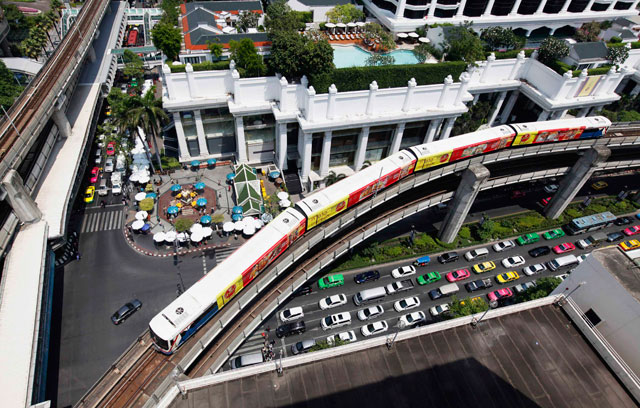Southeast Asia needs to explore new funding channels if its infrastructure is
to keep pace with its economic needs
By Jennifer Meszaros
For years to come, Asean member states will be confronted with the need to find enormous amounts of capital to maintain and expand the region’s infrastructure, which has to adapt to population growth, robust economic development and rapid urbanisation. Between 2010 and 2020, Asia needs to invest $8 trillion in its overall infrastructure to sustain growth, according to the Asian Development Bank (ADB).
The budgets of national governments traditionally play a significant role in funding infrastructure investments, particularly through the adoption of economic stimulus packages. “These packages will continue to be critical sources of infrastructure funding in coming years,” according to the Asian Development Bank Institute (ADBI).

Photo: Reuters/Kerek Wongsa
Big-ticket projects, particularly in the energy and transport sector, have garnered the region’s attention as they serve to increase domestic and regional connectivity. However, “in many countries, particularly those with high public debt and budget deficits, the government may not be in a position to provide further fiscal stimulus,” the ADBI added.
The financial gap cannot be filled by national budgets alone, in particular as infrastructure investments traditionally compete with health and education expenditures. Multi- and bilateral development banks, including the ADB, the World Bank and the Japan International Cooperation Agency (JICA) have therefore been instrumental in supplementing national budgets.
This year, the World Bank will provide a total of $3.3 billion in loans and grants across the region. Indonesia recently was first to receive a $25 million loan from the ADB-supported Asean Infrastructure Fund (AIF).
Development banks not only serve to finance the hard and physical aspects of infrastructure, including railways and roads, but also “play a critical role in improving regulatory environment, supporting transfer and diffusion of technology and improving business and governance practices,” according to the Singapore-based Institute of Southeast Asian Studies (ISEAS).
This “soft” aspect is not only a necessary component in the delivery of efficient infrastructure, but also serves to create an environment conducive to attracting private investors. As such, development banks are increasingly coming to be viewed as catalysts to bolster investors’ confidence through the streamlining of policies.
While some countries have been able to attract investors, the overall reluctance to privately invest is due to a lack of “appropriate legal, regulatory and governance frameworks […] that mitigate political, legal and regulatory risks,” said Biswa Nath Bhattacharyay of the ADBI. “What [Asean] needs is to develop ‘bankable infrastructure projects.’ It needs to create and facilitate the right investment climate so that the private sector can increasingly share the burden of infrastructure financing in the region,” added ISEAS.

Improvements to Asean’s financial markets are important. While bank lending has been another conventional source of funding, macroeconomic conditions, including regulatory capital requirements, have limited borrowing. Now other sources of funding, including export-import (Exim) banks, sovereign wealth funds (SWFs) and bond markets are beginning to take centre stage in funding infrastructure, hence narrowing the financial gap.
Exim banks provide loans, insurance and technical assistance to foreign countries and companies engaged in overseas trade and investments. One of the main benefits of such financing is that the bank offers credit when private
financing is not readily available. Exim banks also benefit from reverse investments and exports as the borrower purchases goods and services from the lender’s home country. This facilitates the entry of the bank’s country into non-traditional markets.
However, there are drawbacks to Exim financing. “Countries or projects do indeed have difficulties in attracting foreign investment. There are usually good reasons why the market will not provide loans or guarantees in such cases,” said Ian Vasquez, director of the Cato Institute’s Center for Global Liberty and Prosperity. “Nations that have done the most to reform have succeeded in attracting voluntary, private money, while those unwilling to change have not succeeded in doing so.” Therefore, Exim banks “relieve host governments of the need to adopt an investment environment that would genuinely attract foreign capital,” he added.
Another option for governments is to tap pension and sovereign wealth funds. Asian central banks have accumulated massive foreign exchange reserves, a part of which has already been channelled into these funds. They are well suited to large, long-term projects that yield a good return. While there is controversy about their size and general lack of transparency, there are “sound reasons to believe that SWFs can promote rather than harm global stability,” said Donghyun Park, senior economist at the ADB.
ISEAS noted that “projects involving public-private partnerships (PPP) are likely to form the basis for financing from SWFs.” Malaysia, Singapore and Vietnam are among the few countries that have utilised SWFs.

The development of local currency bond initiatives, including the Asian Bond Market Initiative, the Chiang Mai Initiative and the Asian Bond Funds, have assumed greater importance over the years, particularly as it serves to integrate the
region financially.
According to Bhattacharyay, bond market initiatives “can promote the utilisation of Asia’s savings and increasing foreign exchange reserves within the region, particularly for use in infrastructure development.” Bond markets are an attractive option for the region to strengthen financial markets as they reduce foreign currency risk for borrowers and minimise currency and maturity mismatches.
Several working groups have already been established to further develop bond initiatives in the region. A well-structured and regulated bond market seeks to boost investor confidence, reduce market-entry constraints, broaden the investor base and facilitate cooperation according to the Asia Bond Monitor. The challenge is whether Asean can develop and maintain transparency and regulations in its bond markets. However, current “steps appear to be moving in the right direction,” noted Bhattacharyay.
Asean’s ability to meet the annual $600 billion in infrastructure needs that the ADB has identified primarily lacks strong government input. As the region moves towards the goal of creating a seamless Asean by 2015, member states’ ability to invest with flair and savviness will clearly determine the region’s growth prospects.

